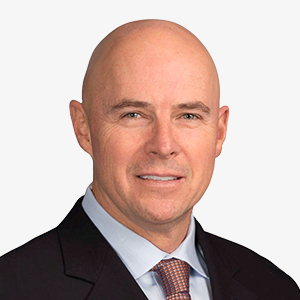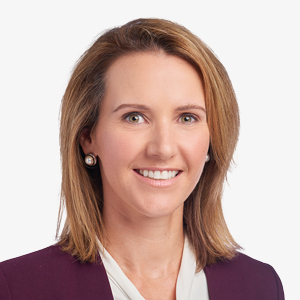Asset Allocation Committee Outlook
—Erik L. Knutzen, CFA, CAIA, Chief Investment Officer—Multi-Asset Class
—Niall O'Sullivan, Chief Investment Officer, Multi Asset Strategies – EMEA
An uncomfortable sense of déjà-vu hung over this quarter’s meeting of the Asset Allocation Committee (“the AAC” or “the Committee”). Three months ago, we reflected upon how much we got right about the economy and markets in the first quarter. We puzzled over the resilience of equity markets and worried about the valuations of U.S. mega-caps, but concluded that investors were being “paid to be patient” until more attractive entry points appeared. Going into the third quarter, the economy has continued to progress in line with those views, but equity markets have kept going up, driven ever more by U.S. mega-caps. Should we reconsider our medium-term economic outlook? Should we reconsider our fundamental view on equities? Should we try to reconcile our cautious medium-term market views with seemingly strong short-term dynamics? Faced with these questions, our quarterly discussion spanned a wide range of perspectives, with the focus of debate falling on the conflicting signals from our shorter-term outlook (which is more positive for equities) and our medium-term view (which remains cautious, driven by the negative impact of higher rates, sticky inflation, tighter financial conditions, and ebbing liquidity). The result was a general move toward neutrality in our views, with notable exceptions in private equity and credit. We remain vigilant for the catalysts that can realign markets with longer-term economic fundamentals, and ready to take a more active view when the time comes.
Given the destruction of the medium-term signal by the shorter-term noise, an important first step is to review what we believed and stated versus how it worked out. Inflation has been sticky, central banks have been more aggressive than expected, economic growth has slowed, analysts’ corporate earnings forecasts have declined, and bank failures have confirmed our concerns about the fragility of the system when rates rise so dramatically. Those things have been true through both quarters. During the second quarter, the Silicon Valley Bank and Credit Suisse failures were followed by the collapse of First Republic Bank. Concerns about the debt of overexposed sectors of U.S. commercial real estate have grown. After a dip when the bank stresses first appeared, market pricing for the year-end fed funds rate moved decisively toward our own view, removing all projected rate cuts. And in the markets, investors have indeed been “paid to be patient,” with cash returning around 2.5% in the first half of the year and short-dated high yield returning almost 5%.
There has been one fly in the ointment, however. We have been cautious on equity markets, and especially U.S. mega-caps, and their performance has been very strong so far this year, particularly compared with the “relatively certain” returns generated by fixed income assets.
This concentration of leadership in larger stocks has been a worldwide phenomenon, but it has been most pronounced in U.S. indices— particularly in the second quarter, as the so-called “Magnificent Seven” biggest stocks exhibited outsized performance. According to Absolute Strategy Research, by the end of May the top decile of U.S. stocks accounted for almost 75% of total U.S. market capitalization— more than during the dotcom boom or any other time over the past 90 years.


Extremes like this have always tended to resolve. But will this one resolve via a correction for the Magnificent Seven or via catch-up by the rest? If the outcome is biased to the former, that would be bearish for the index; if it’s biased to the latter, it would be bullish.
Three months ago, we put this divergence down to still-high levels of excess liquidity looking for relatively attractive destinations, systematic programs covering shorts and buying last year’s losers, and a growing tendency for U.S. mega caps to trade as defensive assets. Since then, the exuberance around generative artificial intelligence has added further impetus, as these stocks have been identified as potential major beneficiaries of this technology.
These are very conflicting signals. These stocks may be perceived as defensive, but if the growth slowdown implied by their outperformance materializes, can they really continue to trade at current multiples? And if they have been rising because AI will be transformative, wouldn’t the implied productivity gains benefit the broader economy?
Goldman Sachs is among those making a first attempt to quantify these potential benefits. It estimates that AI could boost productivity by as little as 0.25 percentage points and as much as three percentage points over the next 10 years, with a baseline of 1.5 percentage points. Given the baseline outcome, it estimates there would be 5.4% compound annual growth in the S&P 500’s earnings over the next 20 years, compared with the 4.9% rate that its analysts’ models currently assume. Goldman Sachs says that would point to a fair value for the S&P 500 Index that is 9% higher than today’s.1
It adds, however, that deteriorating near-term economic growth “would likely more than offset the potential long-term boost from AI adoption, especially given the extreme uncertainty around AI implementation.” Goldman Sachs’ analysts observe that AI adoption would need to translate into a 1.5-percentage-point increase in long-term EPS growth estimates to offset the typical 15-percentage-point cut to near-term EPS growth estimates around recession. That would be far above even the 0.9-percentage-point boost that they model for their “Larger Boost” scenario.

To complicate matters further, recent weeks have brought some evidence that the equity market rally might be broadening, with cyclical stocks and equal-weighted indices making up some ground. That could be a sign that discretionary investors, who tend to shun mega-cap stocks, have been joining systematic programs in closing their equity underweights. In addition, our analysis of broader market sensitivities has started to suggest that investors might be switching their attention from concerns about inflation and monetary policy to optimism about nominal growth. If inflation continues to decline while remaining above policy-maker targets, if interest rates are nearing their peak, if the job market remains resilient, and if the consumer is adjusting to the idea that the new environment is here to stay, investors may feel able to focus on the bright side of current conditions: stabilizing demand, and resilient nominal growth in corporate earnings and the broader economy.
Moreover, those looking for reassurance that leading indicators for the U.S. economy may be nearing a trough, and recession could be avoided, can point to the inventory overhang in Purchasing Managers’ Indices (PMIs). Running down that post-pandemic overhang may explain a lot of this year’s weakness in leading indicators, and reaching equilibrium might allow them to recover and reconverge with the current economic growth data. The prospect of more stimulus coming from China might be another reason to think a U.S. or global recession can be avoided (see “Up for Debate: Might stimulus from China give the global economy a boost?”)


We see the case for this optimism over the shorter-term. We also recognize the growing uncertainty about how this cycle is going to play out. One need only look at the latest “dot plot” of interest rate projections from the U.S. Federal Reserve (Fed): estimates for the policy rate at the end of 2024 range from 3.6% to 5.9%, and for the end of 2025, there is a chasm of 2.4% to 5.6%.
Nonetheless, we on the Committee broadly agree that our cautious medium-term economic outlook remains valid. We do think that interest rates are at or near their peaks at the Fed and the European Central Bank (ECB), but we do not expect them to be cut in the near future; and, as we mentioned, futures markets have come around to our view over recent weeks. We believe the Fed will look to maintain a real policy rate of 1 – 2% and we think U.S. core inflation will end the year between 3.5% and 4.0% this year. Mopping up the last bits of excess inflation often takes longer than clearing the more transitory drivers.
We acknowledge that corporations have so far managed higher rates and rising costs much better than we anticipated, and that this has enabled them to benefit from high nominal growth. However, with nominal growth set to decline, no relief from high rates in sight and excess liquidity continuing to drain away, we think profit margins will continue to be squeezed, earnings will decline further, credit conditions will tighten and more financial accidents could occur.
In the end, it comes down to timing. We remain confident in our cautious outlook for the next 12 to 18 months, but we see increased evidence that stocks could continue their strong momentum over the next three to six months.
In response to these dynamics, we decided to move many of our views to neutral, including on equities. On the map of our views, this looks like an upgrade for equities—but that comes with heavy caveats.
While broad equity market indices are still generally below their peaks, especially adjusted for inflation, we are now even more wary of U.S. mega-cap valuations than we were three and six months ago. Among the Magnificent Seven, only Meta and Nvidia have grown their earnings this year, let alone grown them enough to justify current prices. Take out those seven stocks, and the S&P 500 Index’s forward price-to-earnings ratio declines from a steep 19-times to a more reasonable 17-times.
In addition, we neutralized our view on value stocks over growth. Regionally, we retain our positive outlook for Japanese equities, where we see both attractive valuations and a structural turn to more shareholder-responsive governance structures and culture; and our underweight view in Europe due to growth concerns.
At the same time as upgrading our equity outlook to neutral, we have downgraded our high yield outlook to neutral. This can be seen as part of the broader move to neutrality—together with the upgrade of equity, the changes are to some extent “beta-neutral”. It also reflects a change in our fundamental view on credit. When U.S. high yield spreads fall meaningfully below 500 basis points, we no longer think they compensate investors for the growing stresses we see building in some pockets of the market. Moreover, we increasingly anticipate that signs of a deepening of the economic slowdown will show up in credit markets before they show up in equities. It is from here that we anticipate the signal to change our views from neutral when the time comes.
We remain favorable on investment grade, mainly because financials appear attractively valued, but we see more opportunity in mortgages, municipal bonds, securitized credit and emerging markets sovereign bonds.
In alternatives, we downgraded our view on commodities from overweight to neutral and retained our overweight views on hedged strategies and private markets.
While the long-term supply and demand characteristics remain favorable for commodities, we think the movement to a market that is trading (slowing) growth rather than (sticky) inflation is less positive for the asset class over the medium term. This, allied to disappointment at China’s growth and stimulus efforts so far (see “Up for Debate: Might stimulus from China give the global economy a boost?”) has moved us to a neutral view. Our overweight view on hedged strategies reflects that they are lower-beta by design and seek to take advantage of an environment characterized by volatility and dispersion.
Private markets are, by their illiquid and long-term nature, less exposed to the conflict between our short- and medium-term views. Here, the potential for cross-currents comes, not between three- to six-month views and 12- to 18-month views, but between 12- to 18-month views and the 18- to 36-month views that lie beyond our outlook horizon. As a reminder, our views concern today’s marginal dollar commitments rather than existing, legacy deals, and those new commitments are likely to be put to work over a period of three or four years. Most of those deals will therefore be struck during our 12- to 18-month outlook period. Should the economy and asset valuations hold up better than expected in the near term, it should not make a big difference to final outcomes; should they hold up better than expected over the next 12 to 18 months, that would imply that we should have taken a neutral view today; and should the growth and valuation trough come in 18 to 36 months’ time rather than 12 to 18 months’ time, we will wish we had taken an underweight view today. That is why we retain our overweight view on private markets. We see particularly attractive opportunities in areas that are running chronically short of capital and liquidity, such as private debt, private equity secondaries and co-investments.
Three months ago, we reminded our readers that investors are being “paid to be patient.” In most ways, that view has been vindicated—moving into the third quarter, a little chastened by the strength in some parts of the equity market, we have essentially hardened that message. Before, we had a preference for active caution on equities, compensated by the high rates available in cash and short-dated bonds. Now, we embrace the wait-and-see ethos more fully, with a near beta-neutral set of views. Our medium-term economic and market views remain consistent; and, much like the policymakers at the world’s major central banks, we remain vigilant for the catalysts that will realign markets and economic fundamentals, and ready to take a more active view when the time comes. Although the gears are in neutral, the engine is still running.
In June, Joe Amato and Erik Knutzen both made their first visits to colleagues and clients in China since it lifted its most recent Covid-19 restrictions. Both were struck by the cautiousness they encountered when discussing the economy and market.
In our Outlook for the fourth quarter of 2022, we were also expressing caution due to “uncertainty around the zero-COVID policy.” The importance of this huge economy was one of the reasons for our growing doubts about global growth. By the same token, as it became clear that the authorities planned an aggressive re-opening, our view coming into the first quarter was more optimistic: we started to identify a strong recovery in China as one of the risks to our central, cautious global outlook.
So far, the recovery has been disappointing. Manufacturing growth has stalled, with particular weakness in exports. Growth in fixed asset investment has been lackluster and declining. The real estate sector continues to be a headwind.
Over recent weeks, however, talk has turned to the prospects for fiscal stimulus announcements, with a focus on the next Politburo meeting in July. The People’s Bank of China (PBOC) has already cut three of its key interest rates and the government has announced some measures to support businesses, including tax breaks and targeted loans. Further cuts to the PBOC’s reserve requirement ratio for China’s banks are thought to be in the cards, alongside an easing of home-buying and credit restrictions to help the real estate sector and more local government bond issuance to give impetus to infrastructure projects.
Could this be the boost the global economy needs as growth falters in the U.S. and Europe?
We think that is less likely. It helps that China is in a very different cycle than the developed world, with almost non-existent inflation. That may offer some room for stimulus. Unfortunately, it also faces debt-sustainability problems that stimulus may exacerbate. It is notable that, despite growing weakness in housing, the PBOC disappointed the market with a smaller-than-expected cut to its loan prime rate. There is also a big question regarding the market’s appetite to assume more debt, potentially leaving the authorities pushing against a string.
We think modest stimulus could give a boost to China’s lagging stock market, but we retain a neutral view for now, and we do not believe it will have a meaningful effect on global demand.

We have maintained our overweight views on both private credit and private equity.
In private credit, we see unlevered double-digit, floating rate yields with attractive terms for lenders, on deals with equity cushions of close to 60%—as thick as they have been since 2009 – 10. But if senior lenders have hardly ever had it so good, why do we also maintain such a favorable view of private equity, especially when lenders are receiving equity-like returns?
It’s important to put senior private credit yields in context, and there are two key questions to ask.
First, how long are these high yields likely to last?
The cost of debt (and lenders’ returns) may be high today, but a private equity investment may have a lifespan of a decade: a floating-rate loan made in 2023 may be a lot cheaper to service or refinance in two, three or five years’ time. Downward pressure could come not only from a cut to policy rates, but also an increase in competition from the growth of market participants and the return of the syndicated loan market. And of course, the higher the rate a company has borrowed at, the sooner the private equity manager will opt to refinance.
In other words, this is partly about time horizon: now looks to be a great time for private credit; but it can also be a good time for private equity, because, costly borrowing may be characteristic of one or two years of a decade-long lifespan.
The second question is, how might private credit fare if and when the default rate rises?
Private credit has yet to be tested in a default cycle. Some loans made in the low-rate era are now stressing borrowers’ coverage ratios, potentially requiring more engagement and potentially workouts from lenders. If lenders fell short on credit underwriting over the past few years, they may now have to divert resources away from new lending opportunities and onto managing the existing portfolio.
Adjusted for these and other risks, we think estimated returns to private equity remain competitive with those for private credit, particularly as the upside in private credit is largely capped at contractual cash income. By contrast, private equity’s ability to make outsized returns through multiples of investment generally enables it to more than offset any impaired equity.
The private equity market has been tested through, and taken lessons from, several cycles. Most recently, there has been an ongoing trend for more equity in capital structures, which is leading most private equity managers to assume little or no multiple expansion when they underwrite current deals. Even so, we note that those estimated returns remain much the same as they were five years ago, suggesting that the loss of leverage-fueled multiple expansion can be more than offset by earnings and cash-flow growth. That, in turn, reflects that tight credit conditions are focusing the industry on high-quality deals, where the buyer has a well-worn, sector-specific playbook for unlocking cash flow, enhancing organic growth, achieving transformative growth via acquisition, or all three.
Tighter credit conditions are also fueling the rise in two sub-sectors of private equity that we find particularly attractive: GP-led secondaries and mid-life co-investment deals. GP-led secondaries enable private equity managers to hold onto existing portfolio companies in a “continuation fund” with new investors. Similarly, a mid-life co-investment is a co-investment in an existing portfolio company, rather than a new deal. Both enable private equity managers to provide some form of liquidity to the original investors (without going down the traditional exit routes); and to raise growth capital for investment or acquisitions on behalf of their most seasoned assets (without going to the costly debt markets—with no change of control, existing, cheaper debt can be maintained). The new investors get exposure to high-quality companies, and management teams and growth playbooks that have already been proven with the same private equity manager and are therefore lower risk.
One of our strongest investment beliefs over the past year, and looking through to 2024, is that the current volatility and liquidity constraints in the traditional IPO, high yield and leveraged loan markets mean that both private equity and private credit can benefit from having locked up, long-term and flexible capital to fill liquidity gaps. But there is no getting away from the fact that this implies tough times for many. Manager selection in private markets will be critical in this cycle, in our view, because there is likely to be increased dispersion of outcomes. We think conservative private lenders and quality-conscious private equity managers will be the ones to survive and thrive.


- We remain cautious on a 12- to 18-month horizon, but recognize growing economic uncertainty and potential for further market resilience in the near term; this is a move to neutrality more than an “upgrade” to our fundamental view.
- This neutralization extends to the outlook for value versus growth, and to a preference for the equal-weighted index over the capitalization-weighted index, as we remain skeptical of mega-cap technology valuations.
- We remain cautious on a 12- to-18-month horizon but recognize growing economic uncertainty and potential for further market resilience in the near term; this is a move to neutrality more than an “upgrade” to our fundamental view.
- That said, we do retain our more favorable fundamental view on Japan due to attractive valuations and a structural turn to more shareholder-responsive governance structures and culture.
- We remain cautious on a 12- to 18-month horizon, but recognize growing economic uncertainty and potential for further market resilience in the near term; this is a move to neutrality more than an “upgrade” to our fundamental view.


- We maintain our overweight view on U.S. TIPS and investment grade corporates, and continue to favor the short end of the curve (including cash).
- Corporate spreads are now quite tight, but financials offer attractive value.
- We see the most attractive opportunities in mortgages and securitized credit.
- Inflation and central bank hawkishness have started to push government bond yields back up, notably in the U.K., but non-U.S. central banks still have some way to go to catch up with the Fed on policy tightening.
- The downgrade for high yield at least partially balances the upgrade for equities.
- We think that when credit spreads fall meaningfully below 500 basis points, they no longer compensate for the growing stresses we see building in some pockets of the market.
- We maintain our overweight view on emerging markets debt, given attractive relative yields and the potential to benefit from a softening dollar.


- The downgrade for commodities balances the upgrade for equities, making our overall move to neutrality beta-neutral.
- While the long-term supply and demand characteristics remain favorable, we think the movement to a market that is trading growth rather than inflation is less positive over the medium term, especially given disappointment at China’s growth and stimulus efforts so far.
- We favor strategies that are fundamentally uncorrelated (such as insurance-linked strategies, where we now also see attractive value), that seek to harvest a volatility premium (such as option putwrite strategies), or that take advantage of global macro or short-term trading opportunities.
- The generally lower beta of these strategies fits with our overall move to a neutral stance.
- New commitments to vintages raised at the turn of cycles and the start of economic and market downturns have historically performed well, largely due to their investments being made while equity valuations decline.
- We see the most attractive current opportunities in secondaries and co-investments, where the rewards for being a liquidity provider appear outsized as traditional avenues to liquidity are more constrained.
- We expect recent banking stress to meaningfully improve the opportunity for private credit, as it tightens bank-financing conditions for private companies.
- These conditions should also add to opportunities in special situations and capital solutions.
- The sector’s inflation sensitivity is attractive, but recent banking stresses introduce significant additional risk, particularly in the office sector.
- These dynamics have soured investor sentiment and there may already be value opportunities for liquidity providers in public REITs and private real estate secondaries, and to come in primary private markets.
- More structurally, we believe post-pandemic growth dynamics will continue to support key sectors such as data centers, warehouses, industrial and multi-family residential.
- While the USD is still overvalued based on purchasing power parity (PPP) metrics, it is no longer expensive relative to interest rate differentials. U.S. economic data has surprised to the upside while Europe and China have been disappointing, and the USD tends to benefit from risk aversion and global growth slowdowns.
- The EUR remains undervalued and the European Central Bank remains hawkish in pursuit of its inflation target, but EURUSD has been struggling to break 1.10 and market participants are now very long, with European growth prospects dimming.
- The JPY appears very undervalued, especially after depreciating since last quarter. Japan’s growth is lagging and Japanese investors continue to buy foreign assets, shifting from bonds to equities, but domestic inflation is taking hold; the Bank of Japan is expected to further adjust its yield curve control policy later this year, and the JPY could benefit from global risk aversion and any deterioration in U.S. economic data.
- Despite being undervalued in terms of PPP and interest rate differentials, and supported by recent economic data coming in better than expected, stagflation concerns are elevated as the Bank of England is hiking rates into an economic slowdown, causing mounting stress in the housing and mortgage markets, while the government is pursuing fiscal consolidation.
- While Switzerland has a positive current account balance, the CHF is still very overvalued on PPP metrics and the Swiss National Bank has been less hawkish than its peers as inflation data has not exceeded expectations. The currency has also lost some of its traditional haven qualities following the failure of Credit Suisse.














